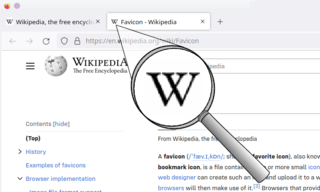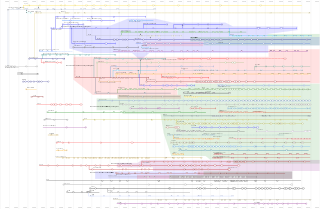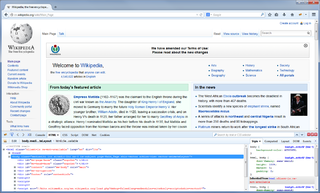Scalable Vector Graphics (SVG) is an XML-based vector image format for defining two-dimensional graphics, having support for interactivity and animation. The SVG specification is an open standard developed by the World Wide Web Consortium since 1999.
Gecko is a browser engine developed by Mozilla. It is used in the Firefox browser, the Thunderbird email client, and many other projects.

Mozilla Firefox, or simply Firefox, is a free and open-source web browser developed by the Mozilla Foundation and its subsidiary, the Mozilla Corporation. It uses the Gecko rendering engine to display web pages, which implements current and anticipated web standards. Firefox is available for Windows 10 or later versions, macOS, and Linux. Its unofficial ports are available for various Unix and Unix-like operating systems, including FreeBSD, OpenBSD, NetBSD, illumos, and Solaris Unix. It is also available for Android and iOS. However, as with all other iOS web browsers, the iOS version uses the WebKit layout engine instead of Gecko due to platform requirements. An optimized version is also available on the Amazon Fire TV as one of the two main browsers available with Amazon's Silk Browser.

A favicon, also known as a shortcut icon, website icon, tab icon, URL icon, or bookmark icon, is a file containing one or more small icons associated with a particular website or web page. A web designer can create such an icon and upload it to a website by several means, and graphical web browsers will then make use of it. Browsers that provide favicon support typically display a page's favicon in the browser's address bar and next to the page's name in a list of bookmarks. Browsers that support a tabbed document interface typically show a page's favicon next to the page's title on the tab, and site-specific browsers use the favicon as a desktop icon.

A browser war is a competition for dominance in the usage share of web browsers. The "first browser war," (1995–2001) pitted Microsoft's Internet Explorer against Netscape's Navigator. Browser wars continued with the decline of Internet Explorer's market share and the popularity of other browsers including Firefox, Google Chrome, Safari, Microsoft Edge and Opera.
This is a comparison of both historical and current web browsers based on developer, engine, platform(s), releases, license, and cost.
Mozilla Firefox has features which distinguish it from other web browsers, such as Google Chrome, Safari, and Microsoft Edge.

Acid2 is a webpage that test web browsers' functionality in displaying aspects of HTML markup, CSS 2.1 styling, PNG images, and data URIs. The test page was released on 13 April 2005 by the Web Standards Project. The Acid2 test page will be displayed correctly in any application that follows the World Wide Web Consortium and Internet Engineering Task Force specifications for these technologies. These specifications are known as web standards because they describe how technologies used on the web are expected to function.
The Web Standards Project (WaSP) was a group of professional web developers dedicated to disseminating and encouraging the use of the web standards recommended by the World Wide Web Consortium, along with other groups and standards bodies.
In computing, quirks mode is an approach used by web browsers to maintain backward compatibility with web pages designed for old web browsers, instead of strictly complying with web standards in standards mode. This behavior has since been codified, so what was previously standards mode is now referred to as simply no quirks mode.
The canvas element is part of HTML5 and allows for dynamic, scriptable rendering of 2D shapes and bitmap images. It is a low level, procedural model that updates a bitmap. HTML5 Canvas also helps in making 2D games.

Firebug is a discontinued free and open-source web browser extension for Mozilla Firefox that facilitated the live debugging, editing, and monitoring of any website's CSS, HTML, DOM, XHR, and JavaScript.

Web development tools allow web developers to test, modify and debug their websites. They are different from website builders and integrated development environments (IDEs) in that they do not assist in the direct creation of a webpage, rather they are tools used for testing the user interface of a website or web application.

Internet Explorer 9 or IE9 is the ninth version of the Internet Explorer web browser for Windows. It was released by Microsoft on March 14, 2011, as the ninth version of Internet Explorer and the successor to Internet Explorer 8. Microsoft released Internet Explorer 9 as a major out-of-band version that was not tied to the release schedule of any particular version of Windows, unlike previous versions. It is the first version of Internet Explorer not to be bundled with a Windows operating system, although some OEMs have installed it with Windows 7 on their PCs. Internet Explorer 9 is the last version that is called Windows Internet Explorer. The software was rebranded simply as Internet Explorer starting in 2012 with the release of Internet Explorer 10.

Web typography, like typography generally, is the design of pages – their layout and typeface choices. Unlike traditional print-based typography, pages intended for display on the World Wide Web have additional technical challenges and – given its ability to change the presentation dynamically – additional opportunities. Early web page designs were very simple due to technology limitations; modern designs use Cascading Style Sheets (CSS), JavaScript and other techniques to deliver the typographer's and the client's vision.
Animation of Scalable Vector Graphics, an open XML-based standard vector graphics format is possible through various means:

Iris Browser is a discontinued web browser for Windows Mobile smartphones and personal digital assistants (PDAs) developed by the Torch Mobile company. The first version was released in 2008. It was one of the first mobile browsers to score a perfect 100 on the Acid3 test.

Web Compatibility Test for Mobile Browsers, often called the Mobile Acid test, despite not being a true Acid test, is a test page published and promoted by the World Wide Web Consortium (W3C) to expose web page rendering flaws in mobile web browsers and other applications that render HTML. It was developed in the spirit of the Acid test by the Web Standards Project to test the relevant parts that a mobile browser needs to support. The browser has to accomplish 16 different subtests indicated by a 4 x 4 image of green or red squares.
A browser speed test is a computer benchmark that scores the performance of a web browser, by measuring the browser's efficiency in completing a predefined list of tasks. In general the testing software is available online, located on a website, where different algorithms are loaded and performed in the browser client. Typical test tasks are rendering and animation, DOM transformations, string operations, mathematical calculations, sorting algorithms, graphic performance tests and memory instructions. Browser speed tests have been used during browser wars to prove superiority of specific web browsers. The popular Acid3 test is no particular speed test but checks browser conformity to web standards.

HTML5test is a web application for evaluating a web browser's accuracy in implementing the web standards HTML5 and Web SQL Database, as well as the WebGL standard.















